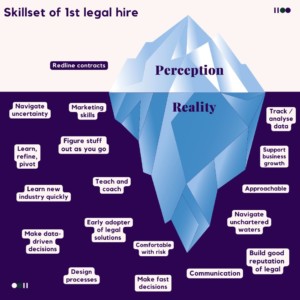New to In-house Legal? 5 Tips To Thrive In Your First 100 Days

Unlike the Head of Legal or General Counsel who joins an already established in-house legal team, the first in-house legal professional has a long list of to-dos to build and act on, and maybe a few fires to put out. The challenge, then, is to do a lot with little resources.
We interviewed Wolfgang Vanas, Head of Legal at ecosio. ecosio is a Vienna-based leading provider of B2B integration specializing in electronic data interchange (EDI), supplier portals, and e-invoicing.
In this article, we put together tips with his help, someone who was the first in-house legal professional of a fast-growing organization. You’ll learn how to navigate the heavy workload and build a scalable foundation for the legal team to become a real business driver.
Read on to discover Wolfgang Vanas’ 5 tips to thrive in the first 100 days as an in-house legal professional, and to establish a strong foundation to build a department ready to scale up.
Looking for TLDR? It’s here.
1. Get a clear understanding of the moving pieces – including what other departments are about
While this tip might sound logical and intuitive, it is tempting to come in and jump straight in to fix everything – and that is definitely how Wolfgang felt.
Instead, restrain yourself from being everywhere at once and focus on understanding the layout of the landscape within the organization. With 75% of in-house legal teams experiencing burnout, as reported by the Association of Corporate Counsel, this piece of advice seems particularly relevant. Boundaries play a major role in navigating the risks of burnout, so defining the legal areas you need to look at in the first 100 days in your new role, and leaving the rest for your mid- to long-term plan can be a game changer not only for your organization but for your own mental health at work.
Here are some questions to look at instead:
-
What are the processes in place, and what is missing?
-
Who is involved?
-
Generally, how has legal been handled?
Some areas, of course, need to be covered straight away, for example the sales process (how is it set up and is legal needed there?), or standard legal topics like GDPR. “These are things you just need to go and check, and then the work cuts out for itself,” adds Wolfgang.
When asked what books Wolfgang would recommend every lawyer to read, he reckoned that the most important thing for legal professionals to be fully embedded within their organization is to know about the non-legal elements of business. “You need to understand the workings better, and widening your horizon is the greatest thing you can do about it as legal training usually focuses just on legal things.” One of the reasons one might choose to be the first legal person in an organization is that you aren’t stuck in one single area, and likely enjoy having eyes on different sides of the business. So, use your position to satisfy your curiosity and read up on marketing, sales, operations, and learn about how other people do their job, and how yours can have an impact on theirs. Or, like Wolfgang, opt for a Blinkist subscription for bite-size learning.

2. Manage expectations
Being the first in-house legal professional in a company is a double-edged sword: it can be exciting because there’s a lot to do and build, and you have a lot of control over how processes can be set up. But it’s also stressful because, well, there’s a lot to do and build.
Having a clear understanding of what the management team wants the first legal person in their organization to do is key. If, like half of business leaders interviewed for an EY Law and Harvard Law report believe, the organization has lost business opportunities because of inefficient contracting, then having a close look at contract management processes and workflows should be prioritized. If the direction of the business is leading towards establishing stronger partnerships with customers, then offering support in risk management, contract drafting, and contract negotiation will be top of the list.
When it comes to implementing a contract lifecycle management tool, specifically, Wolfgang argues that establishing it as a legal tool to begin with is the way to go. In their own organization, when adopting Precisely, this is how they went about it: “First, we used it to get the whole signature process under control. When that was achieved, we finally rolled it out in self-service to our first department, which was HR. And again, for the whole thing to function, it took some time, but that’s working really well now, and it takes a lot of hassle out of everybody’s mind.”
So, first, get the basics in place, like e-signing and archiving, and then you can bring other departments on board, based on ease or difficulty (quick wins are good for morale, while difficult tasks will be more impactful in the long run).
“Setting up processes takes some time, and you need to be smart in how you allocate your resources. It’s important to remember that not everything will work from day 1, as you might like,” adds Wolfgang.
So, set out the roadmap of where you want to end up, and go from there. More specifically, using the quarterly OKRs framework (Objectives & Key Results), you can break down your goals into smaller objectives. This will add focus to your workdays as well as help you clearly see progress.
3. Adopt a transparent and “better safe than sorry” approach
One of the biggest struggles of in-house legal departments is raising legal awareness: helping the rest of the company understand what legal is about, when legal needs to be involved, and when it doesn’t.
Wolfgang shares: “For so long [at my organization], everything worked without having a legal person involved. Back then, if you got a legal person in, it was an outside counsel needed for specific projects. That person was not involved in day-to-day operations.”
Along those lines, in their guide “Establishing the In-House Law Department,” the Association of Corporate Counsel also argue that building relationships within an organization is crucial to the well-functioning of the legal department. They recommend that in-house legal departments communicate openly, for example, with the help of individual meetings or even a written handbook documenting processes and frequently asked questions. Becoming an “approachable, open door” department can also positively impact collaboration. This latter, seemingly unimpressive, point also goes in line with Wolfgang’s tip on dedicating time to understanding each department and getting curious about the role of legal in their processes (tip #1).
At the end of the day, it’s about getting people to think about legal, argues Wolfgang. Initially, he had to ask people across the organization to “please start thinking of including me. People weren’t familiar with having a legal person, so one big challenge was to change people’s minds. Sometimes people have expectations around what legal does and does not, and that doesn’t always align with reality. For some things, people were astonished to see that legal was involved, whereas sometimes they would expect legal to be involved when it wasn’t.”
Besides, helping the company understand what legal does can have significant impact on the efficiency of processes once legal decides to build a self-service where everyone in the company can manage the parts of legal that don’t need legal involvement, like drafting standard HR or Sales agreements once legal has set up templates.
According to Wolfgang, asking people to come and ask questions was the best way to start educating the company on legal issues and ultimately, to help legal do their job as well as possible. Luckily for him, people took him up on his offer which, he shares with a smile on his face, made his life a whole lot easier. So, adopting a “better safe than sorry” approach might be the simplest yet most effective way to start establishing strong ties with the rest of the company, and raise awareness on what legal is all about.
Transparency is also a quality that Fiona Konetzky, VP Legal & Compliance at Adverity, argues can have a great impact on legal becoming a key driver of business – and she speaks from experience. If you’re looking for more tips on how to implement a contract lifecycle management tool across your entire company, watch our webinar interview with Fiona and Dani Manfreda, Deputy Head of Legal & Compliance at Adverity here.
4. Prioritize the adoption of a contract lifecycle management (CLM) tool
Like many first in-house legal professionals, Wolfgang came to an organization that stored contracts on Google Drive. One of the managing directors sat down early on with him to show him around, and gave him free reign to change the way contracts were stored. Initially, Wolfgang thought adopting a CLM would have to wait until later since there were so many other things he’d rather focus on, but he quickly realized that his priorities had to shift.
“I wanted to get an overview over some contracts, especially important ones. We had everything […] neatly stored, but you looked at a graveyard of contracts laying around, not knowing any of them. I had no idea what they were for, who was responsible for that contract, was it terminated, was it an old one, was it active, and that’s when it hit me: this is something I should have control over, but I don’t. That was my tipping point when I said okay, we need to do something about it and look for a CLM tool.”
Wolfgang’s experience is very likely to resonate with fellow lawyers trying to understand what systems have been put in place prior to their arrival, but it is also a reflection of the challenges experienced in the legal industry as a whole. In fact, 87% of legal department leaders say they spend too much time on low-value, routine tasks* – like looking for contracts in a cloud drive that is not fit-for-purpose. In addition, half of business leaders believe inefficient contracting has led to lost business,* meaning that, contract management, if built strategically and with the right tools in place, can be a real business driver for the organization – and no longer be perceived as the road blocker in business development.
* Source: Bloomberg Law – Corporate Legal Heads Face More Work, Budget Cuts, Survey Says
So, how do you go about choosing a CLM?
For Wolfgang, the main thing was to have a good archive and e-signature tool. “Those were my expectations, […] but I soon realized that a good CLM tool has a lot more to offer, which I wasn’t aware of. Seeing it for the first time was a really cool experience, and still is today. You can set up a self-servicing template, it’s quite fun, kind of like doing a logic puzzle.”
Ask the vendor, seeing them as a consultant, what other functionalities you can expect to do besides your top priorities, like facilitating collaboration across departments or automating approval workflows.
Another thing to be aware of is use of the CLM tool beyond the legal team, which again links back to Wolfgang’s earlier tip on understanding how other departments function (tip #1).
“When looking for our CLM tool and finally choosing Precisely, I was looking at it from my perspective: I was looking for a legal tool. It took me some time to finally realize that this was much more and it’s best if you find a use for it, but when I first saw all the features, I have to admit I didn’t know how I was going to use them.”
The trick then, is to take the knowledge you have of other departments into your CLM research. Based on what other teams need and how they have been processing and monitoring contracts, what functionalities do you need? For example, does Sales need advanced formulas in order to automate their price calculations? How does HR keep track of employee contracts? All these questions should help guide your CLM selection process.
Now, he finally feels that he has things in control when it comes to contract management. Everyone involved can fall back onto a clear process to follow, and everyone gets to be more active in contract management, and everyone has visibility over what they can take charge of. And of course, that allows in-house legal to have some load taken off its shoulders and focus on other projects that only they can bring value into rather than manual, repetitive work that can be automated and delegated across other teams.
This point leads us to our final tip to other first in-house legal professionals: to think strategically so the work you are doing today will have a long-term impact on the company, and so that everything you build will be foundational to a future, growing in-house legal team.
5. Think ahead and think scalability
Another likely possibility when hired to be the first in-house legal professional, especially in a fast-growing company where business is constantly evolving, is that you were hired for your strategic thinking. When Wolfgang joined ecosio, he realized early on that while many of the current processes when it came to contract management were functional, they wouldn’t be easily replicated and followed through were the company to grow to 200 employees instead of 50.
For example, when Wolfgang joined ecosio, “there was no system for following up [on contract reminders and deadlines]. Contract owners, everybody had to get their contracts under control, we’ve been very lucky that people were extremely consistent – we still have a lot of people who were there right at the beginning so they know. But once there is change, that whole system would come crashing down. Being the first person in a fast growing environment, you always think about the scalability, and I realized that this was not scalable. As more and more people join, there will be more contracts, so even if it’s fine for now because you have a limited amount of contracts, it’s going to grow exponentially.”
Understanding that the legal function needs to be scalable can make a world of a difference, and not just for the business, for the legal function as well: if you have to be the one people rely on to understand, track, and solve legal-related matters, the chances that you’ll get stuck in routine, manual work are high.
“Having Precisely as a CLM tool has given me the control I was looking for. I feel comfortable now that even though I’m giving away some of the control, I’m still part of the process and I can still be involved if I see the need to. Nothing goes unnoticed.”
When the demands on the legal department rose with the natural growth of the company, that mindset bore fruit. The legal department was ready to scale: while a new colleague joined Wolfgang, they were able to handle the much-increased legal requests while keeping the stress levels low.
So, right from the beginning, understand that the systems you are setting up need to hold in the short, medium, and long term. Focus on finding repeatability in what you do: set up workflows, systems, and adopt the tools that can help further automate these processes.
TLDR & Final Thoughts
- Get a clear understanding of the moving pieces – including what other departments are about
Not only will understanding what other departments do will help you set up your processes better, but it will also help you embed the in-house legal department in the organization.
- Manage expectations
Building a legal department from scratch is a lot of work. Break down your goals, use OKRs, and remember that setting up an in-house legal department will take time–especially if you’re on your own.
- Adopt a transparent and “better safe than sorry” approach
Help the organization understand what legal does, when your input is needed, and when it isn’t. Ask to be involved in other departments’ legal activities, and communicate clearly what your role is about (e.g. with the help of FAQ and guidelines).
- Prioritize the adoption of a contract lifecycle management (CLM) tool
Contract management might be the least exciting part of an in-house legal professional, but that you should have control over. Adopting a CLM will give more visibility over contracts, and more control without necessarily being involved, meaning you’ll have more time for other exciting tasks.
- Think ahead and think scalability
Although processes might work perfectly as they are in a small organization, consider what would happen if instead of 50 employees, the company grew to 200 – would the processes still hold? Thinking ahead can also help in-house legal to become real business drivers.
Being the first in-house legal professional is no easy task, and one that requires not only traditional legal knowledge, but also a strategic mindset and a curiosity to test things out. Across this article, we have gathered Wolfgang Vanas’ experience being the first in-house legal professional at his organization to give you the tools to go and establish the legal department in your own environment. What tips would you add to this list? Want to share your experience with us? Write to us!
Disclaimer: None of our resources is intended as legal advice.



